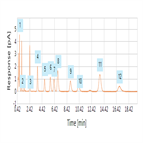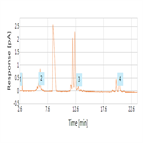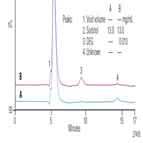Find methods for your needs
Refine by Feature
Displaying 1-3 of 3 results for Tag: mixed mode separation
Determination of Steviosides by HPLC-CAD on UltiMate 3000
Instrument Type: HPLC-CADThis application combines the Acclaim Trinity P1 with charged aerosol and diode array detection to quantify stevioside sweeteners used in foods and beverages. The two detectors are complimentary at higher concentrations of steviosides, but under the conditions used here the charged aerosol detector provides superior sensitivity for most of the analytes.
Label-Free Determination by UHPLC with Charged Aerosol Detection of Glycans Separated by Size, Charge and Isomeric Structure
Instrument Type: UHPLCThis fast and sensitive method is suitable to directly measure the glycan content and profile of glycoproteins. Native N-linked glycans released from proteins by PNGase F are separated on the Thermo Scientific Vanquish UHPLC system by using the Thermo Scientific GlycanPac AXR-1 column. This column employs both weak anion exchange and reversed-phase separation mechanisms to separate glycans based on charge, isomerism and size. The native glycans are quantified directly by using charged aerosol detection.
AN246: Determination of Diethylene Glycol in a Sorbitol Solution
Instrument Type: ICGlycerin, sorbitol, and propylene glycol (PG) are widely used in pharmaceuticals and personal care products. These products are at risk from adulteration by similar, less costly, and very toxic compounds (ethylene glycol (EG) and diethylene glycol (DG)). The United States Pharmacopeia (USP) as directed by the US FDA revised USP 32 NF 26–27 monographs to identify and quantify EG and DEG in PG, sorbitol, and glycerin solutions. Here DEG in sorbitol solution is determined by IC-PAD with Pt working electrode. An ICS-6000 can be used for this application.



